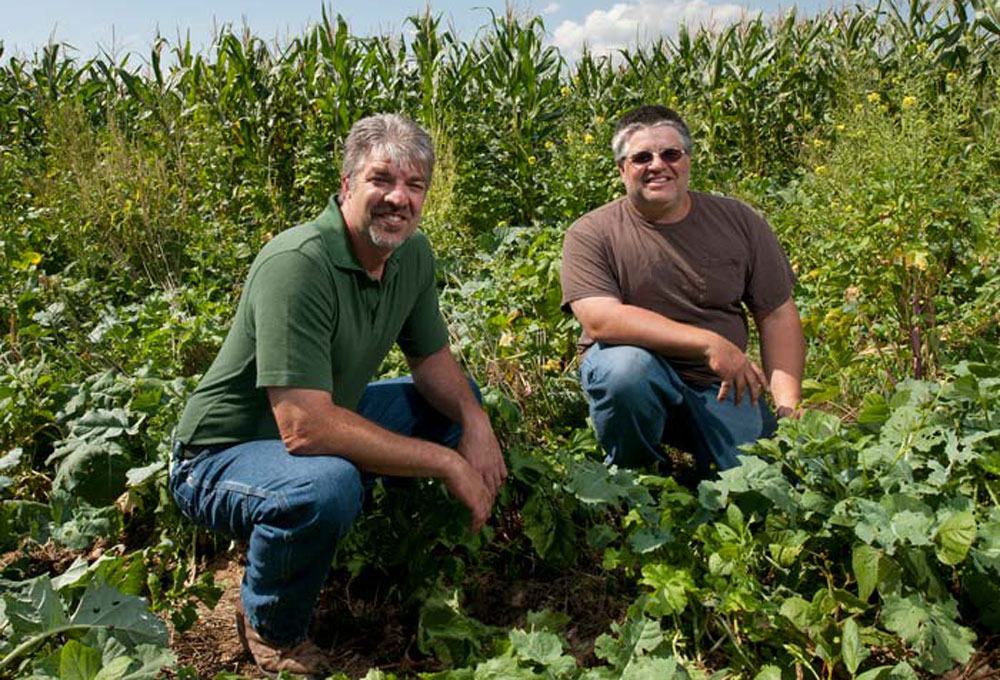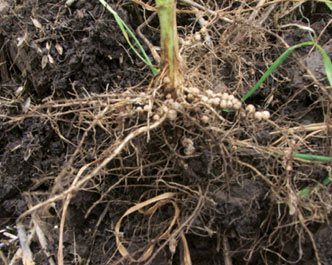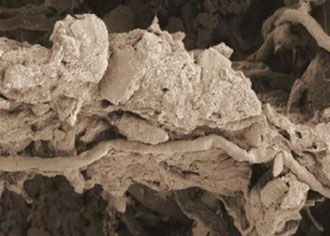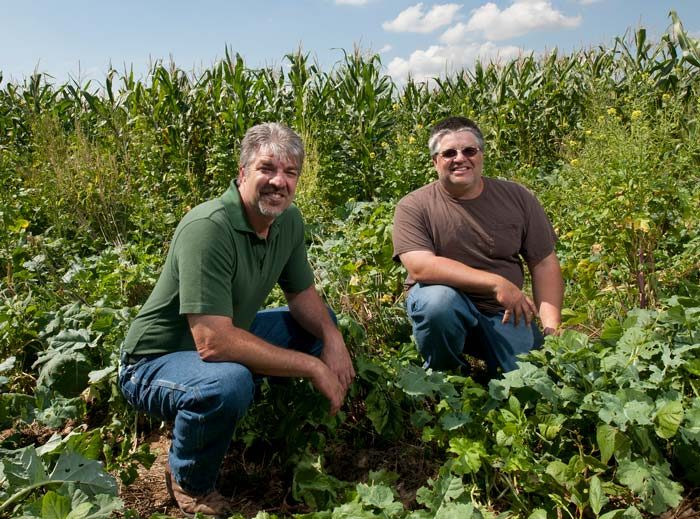Likening a healthy, robust industrial economy to the types of biological activities taking place underground in a no-till, cover-cropped farming system isn’t a stretch of the imagination, says Keith Berns.
“Just as we understand farm economics, we need to better understand our soil economy — and not just in dollars and cents on how much grain we’re hauling to town,” he says.
Keith is a former teacher who, along with brother Brian, no-till 2,500 acres of irrigated and dryland corn, soybeans, rye, triticale, peas, sunflowers, oats, barley and buckwheat near Bladen, Neb. They also co-own Green Cover Seed, a cover crop seed provider established in 2009.
Berns believes in the premise that since land invariably is your largest investment, it must be protected. And with a no-till system that incorporates a diverse selection of cover crops, his land is always covered by crop residue, protected from wind and water erosion, while the soil builds organic matter and structure.
He controls weeds through an integrated program of diverse crop rotations and the efficient use of chemicals.
“We’re still learning, but we are trying to get more diverse, which is one of the keys to a healthy soil economy,” he said.

COVER ECONOMY. Keith (left) and Brian Berns no-till 2,500 acres of irrigated and dryland cash crops near Bladen, Neb. They also co-own Green Cover Seed, a cover crop seed provider. Keith has recently coined the term Carbonomics to explain the important role cover crops play in a healthy soil ecosystem.
Berns came up with the term Carbonomics when he realized the distinct parallels between strong national economic systems and vigorous, carbon-centric soil systems. In a soil ecosystem there are producers and consumers, there’s currency and capital investments, energy and resources, infrastructure, communications and defenses.
The common thread weaving through this healthy soil economy is carbon, he says. It’s what is produced, consumed and exchanged, thus building and protecting a robust soil environment.
No-Till Suppliers
“Aside from the sun that provides solar energy, there are three main components, or players, in this soil economy — plants, soil and animals,” says Berns. “And when I talk about the animals, I’m not just talking about large animals like cattle, sheep or hogs, but primarily the small, soil-based animals such as microbes, bacteria and fungi.”
When water is combined with the energy of the sun, plants produce sugars and oxygen through photosynthesis, which is the absorption of carbon dioxide. Plants are very important for the soil economy, Berns says, because they’re producing carbon for the entire system.
The soil provides nutrients, a habitat for roots and biological activity, as well as water storage. Soil nutrients reach far beyond just major macronutrients to the mineral nutrients, which are important for a balanced economic system, he says.
The soil biota, or animals, provide nutrients for fixation, but also provide nutrients through cycling and availability. The biota also provides much of the defense and protection for the whole system, Berns says.
“When we have all of these suppliers — the biology, the plants and the soil — all working together we have the potential for a very strong soil economy,” he says. “Diversity is important. Just having one type of biology is subject to economic crashes when something changes.”
Nature’s Demands
The soil economy’s three main players — plants, soil and biology — also have needs on the demand side of the equation, Berns notes. “We farmers know that plants need nutrients and water, but they also need services like protection and support,” he says.

In the soil’s economy, Keith Berns refers to Rhizobia bacteria as biological factories because of their ability to fix nitrogen on the roots of legumes — in this case a cowpea plant used as a cover crop.
The soil needs carbon. Soil without carbon doesn’t function well and it also needs services like protection. “Soil is an amazing thing, but it cannot protect itself. It is subject to water and wind erosion if it’s not protected. So it has to contract out its protection to other parts of the economy,” he says.
When it comes to soil biology, those living organisms are identical to human organisms in that they need basic necessities like food and shelter, he says. “If you give soil biology food and a place to live they’ll work fairly cheap for you. They’ll be happy and do pretty amazing things.
“As in a human economy, like that of the United States, one of the leading indicators that we have a really strong, robust economy is when you have low unemployment rates. When everybody’s working, they’re contributing to the system. It’s the same in a soil system,” Berns says.
Applied Welfare
Berns also compared the fate of agricultural soils that are dependent on outside inputs to the challenge posed by the welfare state entrenched in industrialized countries, where some people aren’t contributing to the system.
“When we always provide the plant with everything it needs from the outside — primarily fertility and crop protection inputs — we weaken the economy,” he says. “In essence we’re replacing the biology with a chemical bottle and that breaks the system. When soil biology isn’t present in our system the plant suffers and we step in and provide that welfare system through a jug.”
Berns isn’t advocating that commercial inputs not be used, just not to excess. “We need to make sure we’re not providing too much welfare to our agricultural system,” he says.
Carbon Currency
At the heart of Berns’ soil economy is carbon. Currency is important because it enables the exchange of goods and services between all of the players in the economy. Transactions are smoother due to this common currency.
“In the soil economy we have a perfect currency and that’s carbon, thus the term Carbonomics,” he says.
8 Key Takeaways of Soil ‘Carbonomics’
- Soil economies are intricately interconnected and interdependent. To understand how to rebuild no-tilled soils, it’s necessary to understand soil biology as an interwoven network. If one part of the system is negatively impacted — say through tillage or excessive fertilizer — the whole soil system will suffer.
- Reduce the amount of welfare you give your soil economy. Make sure every component of soil biology is working by providing only those external resources necessary to enable a healthy balance of biological activity.
- Increase your “cashflow” of carbon currency. Think beyond a two-crop, rotation that is only working with the soil 50% of the year. Diversified rotations and cover crops maximize the use of solar energy and production of liquid carbon.
- Invest in long-term carbon and don’t sell off investments. Organic matter produced by activities like growing cover crops and grazing livestock is a capital investment. Incorporating or removing residue in a no-till environment is like selling off long-term investments.
- Take advantage of the free, tiny workers. No-tilled soil’s microorganisms provide valuable labor by doing things like manufacturing N, mining minerals and providing transportation, communications and defenses. Nurturing biological diversity is very important to ensure all these workers are present.
- Build your soil infrastructure, don’t destroy it with tillage. Living organisms in no-tilled soil are the transportation and communications networks that provide for the transfer of vital nutrients, water and oxygen for healthy soil biology.
- Protect your economy with soil armor. Keeping soil covered year-round helps moderate soil moisture and temperatures, ensuring that biological activity stays protected and remains active.
- Diversity is the most important aspect for a healthy soil economy. Develop ways to introduce both plant and biological diversity into your cropping systems. The healthy interactions between plants, roots and biological organisms depends on diversity.
Plants produce carbon through photosynthesis, pulling CO2 out of the atmosphere and converting it into sugar molecules. That carbon molecule is then recombined into many other compounds used throughout the soil system to purchase goods and services, Berns notes.
“Plants use the carbon they produce to make payments through root exudates,” he says.
“They’re actually making payments to the soil biology and in exchange they’re getting services. Among those services they’re receiving is a supply of nutrients, moisture and protection. Soil biology doesn’t work for free, so the payment is through carbon.”
Berns explains that while carbon is one of soil’s most important compounds. It’s also the most overlooked of all plant health components, as the focus in production ag continues to be on nitrogen (N), phosphorus (P) and potassium (K). “When’s the last time your sat down with your agronomist and said, ‘We need to plan for how much carbon we’ll need for our next crop.’”
Berns says carbon is the main food source for soil biology and a soil lacking in carbon will also be lacking in biological activity. Increasing a soil’s carbon currency normalizes soil pH, increases the cation exchange capacity of the soil, increases availability of many of the important macro and micronutrients and reduces the availability of some harmful elements, like sodium or aluminum.
Carbon Capital
“The liquid form of carbon is what moves throughout the plants and soil. That’s like cash because it’s just immediate. Liquid root exudates are the best form of liquid carbon,” Berns explains.
“The solid carbon, which is in our living organisms and built into the humus and organic matter, that’s like a savings bond available for more long-term, stable investments.”
Capital savings can’t be increased without an excess of cash income, and organic matter can’t be increased without an excess of soil carbon currency, Berns argues.
“A corn/soybean rotation is not enough to build soil organic matter (SOM). Corn-on-corn, or having wheat in the rotation, can build SOM slowly without cover crops, but with covers it all goes much faster,” he says. “Carbon that enters the soil through the roots is more effective at building SOM than carbon that enters the system from the decomposition pathway.”
Berns likens growing cash crops without cover crops to living paycheck to paycheck. Outwardly someone may appear stable, but there isn’t any extra capital for investments. There is no margin for error. The same is true with soils.
“Unless we’re producing more carbon than what the crop is requiring, we’re hauling carbon away in a truck with the grains,” he says. “That’s the beauty of no-tilling with cover crops. We produce all this carbon for the soil and we’re not hauling any of it away. That’s the way that we start to build the organic matter and build up that savings account and soil resiliency.”
Energy & Resources
In Berns’ economic system, the economy for the plants and soil ecosystem is driven by solar energy. Farmers plant seeds and out pop small solar collectors, which have a distinct advantage in utilizing this free energy source.
A healthy soil economy does not require significant amounts of purchased energy inputs as is evidenced by the deep soils of native prairies, he says.
“If you look at the energy budget of a typical farm, ours included, normally you would think about how much is spent on diesel fuel, natural gas or propane. But the biggest energy expense we have as farmers is N fertilizer because N is a very energy-intensive process to produce, transport and deliver,” Berns says.
“If we want to reduce energy consumption on our farm, then we need to look at fertilizers and not just diesel.”
From a resource perspective, Berns says the No. 1 resource that our plants need is carbon. The No. 2 resource is N. While plants capture the carbon they need from the 0.04% of available CO2 in the Earth’s atmosphere, plants are unable to use the more than 76% available N in the air.
“The good news is that N in the atmosphere is inert and we’re not dead, but the bad news is that we have to buy N and that’s an expensive process to manufacture,” he says.
While man has created industrial processes to manufacture N products, Berns says there are also biological factories in the soil that fix N on the roots of plants. Rhizobia are special types of bacteria that will colonize and form these N-fixing factories on the roots of legume plants. Although it takes a specific type of bacteria for certain legume plants, they form colonies that are essentially N-producing factories.
“But Rhizobia bacteria don’t do it for free,” Berns says. “Because as cool as Rhizobia are, they cannot produce their own food and are completely dependent upon the plant as its food source. So plants are willing to pay the bacteria in carbon, via sugars on the root exudates, for the service of being able to get N.”
Berns also notes this process isn’t limited to legumes and Rhizobia bacteria. Other free-living soil organisms like Azosprillum and Azotobacter don’t have to associate with a specific legume plant and can associate with grass plants.
“They’re not as active fixers of N and may only fix 20-40 pounds. If you’re trying to grow a 200-bushel corn crop, that won’t go too far,” he says. “But if you’re just growing a cover crop or a forage crop, what does 40 pounds of N do for those plants?”
Bringing his analogy back to the welfare system, Berns notes that in order for this production to happen, the soil bacteria and plant must be connected to trade N for carbon. These free-living bacteria will not work if there is excess N already in the soil because the plant is not willing to trade its carbon when it doesn’t have to pay for N.
“When we overfertilize or have excess N in the soil, these organisms aren’t going to be present in the plant economy because the plant is already getting a handout,” he says.
Plant Networks
Another form of soil biology that taps into the physical form of soil is mycorrhizal fungi. Fungal hyphae have been shown to actually drill into rock and extract iron and magnesium, for example. And like Rhizobia, these organisms must also form an association with plants in order to exchange these minerals and water within root systems.

Fungal hyphae have been shown to actually drill into rock and extract minerals, such as the fungus Talaromyces flavus extracting iron and magnesium found in a Chinese mine.
Mycorrhizal fungi also play a key role the soil economy’s infrastructure system, Berns says. A plant’s main roots mimic a nation’s main highways or interstates. Add a mycorrhizal fungi network to the root system and now the network becomes like a secondary highway system that brings goods and services closer to their local destinations.
“These fungi are very efficient in transporting P, which is one of the most difficult nutrients to get out of the soil,” he says. “But they can also transport N, K and essential minerals. In dry times they can bring in water as well. You can really drought-proof your crops if you have healthy mycorrhizal populations.
“A soil system without Mycorrhizal fungi is a farming system without highways, rail lines or ports.”
Earthworms also play a big role in the soil’s transportation system, Berns adds. Their tunneling enables large amounts of water, oxygen and surface residue to move throughout the soil profile.
“They’re responsible for the transportation of much of the biology throughout the system, acting like a public transportation system,” he says.
“They eat residue, ingest some of the microorganisms, then as they move through the soil they eventually transport these organisms to another place.”
So how does a soil biological system know what the plant requires? Communications.
Berns says plants give off different chemical signals — carbon-based compounds through root exudates — when they need macro or micronutrients. Soil biology reads those signals and returns the proper nutrient. Carbon compounds can be carbohydrates, sugars, proteins, fats, lipids or oils.
“Think of it as plants giving out work orders,” Berns says.
Plants can communicate with each other as well through mycorrhizal fungi networks, which not only grow from plant roots to the soil, but from one plant root to another to create a conduit between plants.
“That’s why diverse plant communities are healthier and more resilient than monocultures,” he says.
Plant Protection
The plant’s soil economy needs to be protected from many things, Berns says. Water, for example, is essential for growth, but too much or too little leads to plant stress.
Aside from water, soil needs to be protected from wind, heat, cold, compaction, weeds and insects.
“The first line of defense is soil armor, simply keeping the soil covered,” Berns emphasizes. “The destructive mechanism of tillage removes residue and exposes the soil, leading to physical breakdown of the soil structure.
“Keeping the soil covered helps protect against water and wind erosion, from hot and cold extremes and against many pathogens that could be splattered on a plant from a heavy rain.”
Berns uses a corn/soybean rotation as an example. It’s essential to plant a cover crop after harvesting soybeans, he says, because soybeans don’t leave much residue after harvest and what’s left breaks down quickly because of its low carbon-to-N ratio.
Cover crops help the ground recover ahead of the following crop.
“When we’re heavily invested in just corn or soybeans it’s not very diverse. You’re not only susceptible to the whims of the market, but to diseases and insects as well.”





Post a comment
Report Abusive Comment